

|

|
In the News
Paul Rose: Master Modeler (Part 1)
Feb 10, 2010


By Noel Widdifield |
Author
Bio
Because Paul is unlike many people in Large Scale, we decided that we should take a look at what he had done with all of his models. The contest winners represent only a very small portion of Paul's work, so I travelled to his home in Damascus, Maryland to interview Paul and see what all he had done.
|
| I met Paul Rose at the East Coast Large Scale Train Show (ECLSTS) this past September at one of the modular railroads on display there. The reason I met him was that I saw a locomotive running on the railroad that I didn't recognize as one from any of the Large Scale manufacturers. Seeing a new locomotive is always an exciting event in our hobby since new locos don't come out that often. I found the locomotive interesting because I had not heard or seen anything about a new standard gauge Consolidation other than the one that Aristo Craft has coming out and this one didn't look anything like the Aristo Craft prototype at the show. 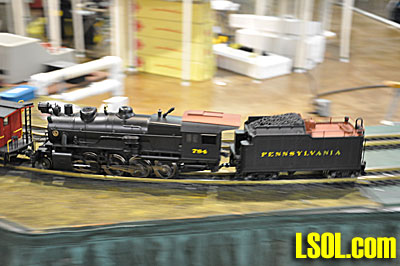 This Connie was on the back end of a long train of cars as a pusher and had features that I recognized, but couldn't place. By asking the guy who was running the PVC Train Runners Railroad modular railroad, I found out that the loco had been kitbashed by Paul Rose.   I ran across Paul later that morning, introduced myself and suggested that he enter his loco in the LSOL.com Model Contest. After some discussion he agreed to enter the loco and a car that he had also kitbashed. I soon discovered that Paul was a very unique individual in Large Scale. He is a model railroader who models standard gauge railroads in Large Scale and cares about modeling so that his products mirror the prototypes. His favorite railroad is the Western Maryland closely followed by the Baltimore & Ohio. Paul's Western Maryland ship's propeller car and the Pennsy Connie won prizes with the Connie winning "Best in the Show". He took home a trash bag full of new models purchased with the winner's rewards from the contest.
   
 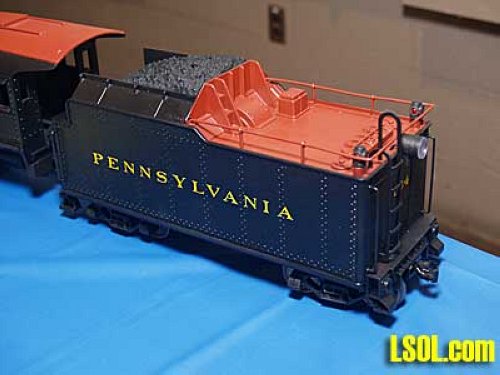 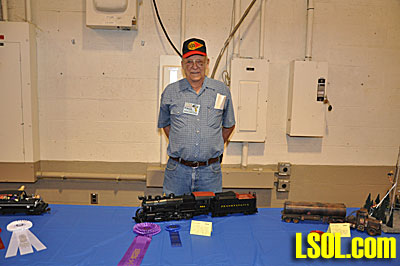
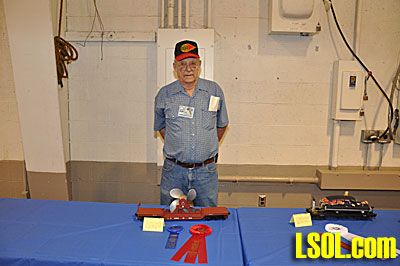 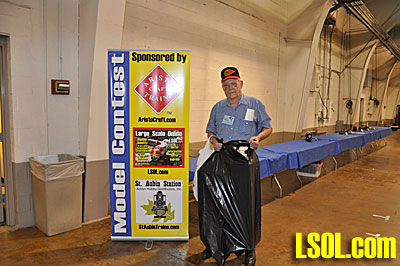
Because Paul is unlike many people in Large Scale, we decided that we should take a look at what he had done with all of his models. The contest winners represent only a very small portion of Paul's work, so I travelled to his home in Damascus, Maryland to interview Paul and see what all he had done. When I arrived, Paul greeted me, introduced me to his wife and took me down to his lower level to show me his trains. 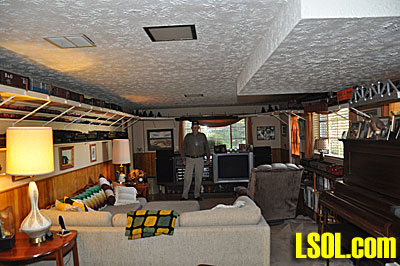 When you enter his family room you are overwhelmed with his collection of trains. They line the walls, run around the ceiling and fill every place in the room. The vast majority are Large Scale, but there are many HO models as well. He built the shelving in 1991-1992. His overhead railroad allows Paul to store many of his locomotives and cars so that they are easily viewed. It also allows him to run his trains so that he can enjoy them without having to build an outdoor railroad. 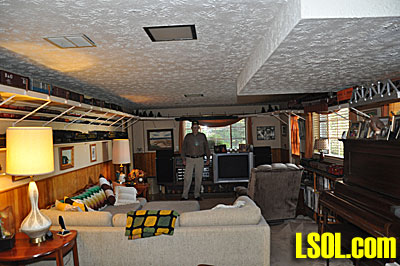 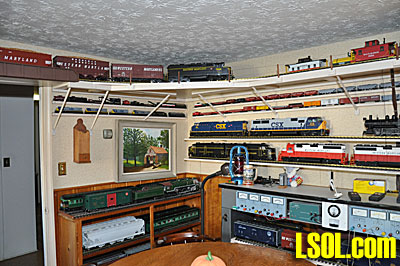 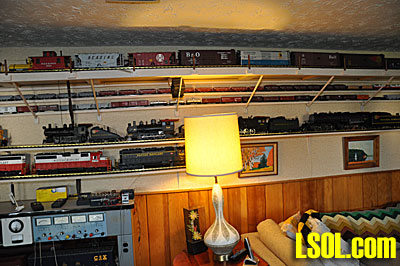
Paul started with trains in the early 1940s when his parents gave him a Lionel train set. By the early 1950's he had a very extensive collection of Lionel trains. He grew up in Maryland and spent some of his youth in North Carolina and northern Virginia. His train days took a few years off for military service in the mid 50s. He left the service in 1956 and he and his wife had settled down in Maryland. During the years he was in the service, his mother stored his trains for him. Unfortunately, when he went to her house to retrieve the trains, she told him, "Oh, you are too old to play with trains, I gave those away to the kids in the neighborhood." At that point he decided that he would move into HO since it was really becoming the major gauge at that time. He remained in HO until "the old eyes wouldn't do it anymore". At that point he thought he would go to O scale and didn't even know anything about Large Scale. This was in the late 1980's and early 1990's, and there only seemed to be narrow gauge stuff at that time. But when he looked in the hobby shops he discovered some of the early Aristo Craft engines and thought that they looked pretty good. 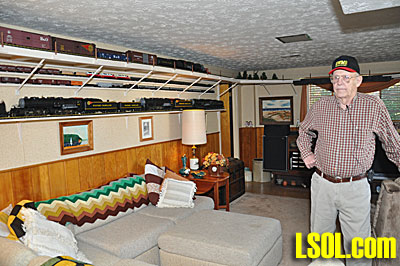 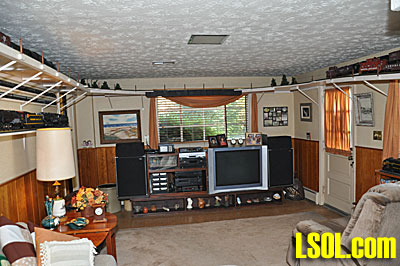 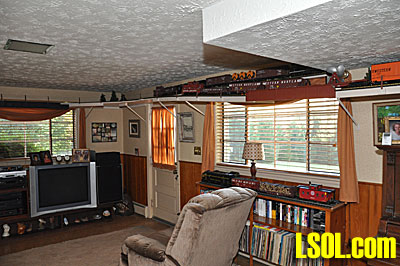
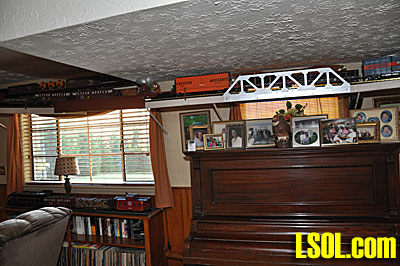 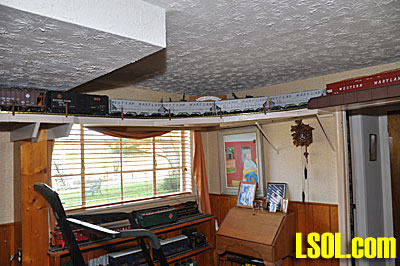 His first purchase in Large Scale was the Aristo Craft Southern Crescent set. He bought that set because he had ridden the Southern Crescent between Washington, DC's Union Station and the Carolinas as a young man. The Southern Ps-4 Pacifics pulled the Southern Railroad passenger trains and they were painted a beautiful green. In later years they swapped the Pacifics for E-6's or E-7's, but the steam engine really appealed to Paul. A pair of Aristo Craft Baltimore & Ohio FA's and an FB soon followed the Crescent set. 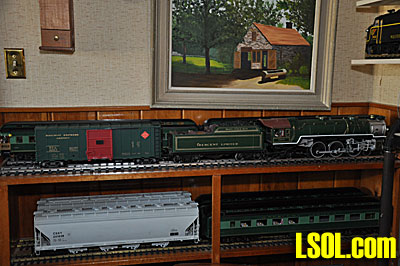 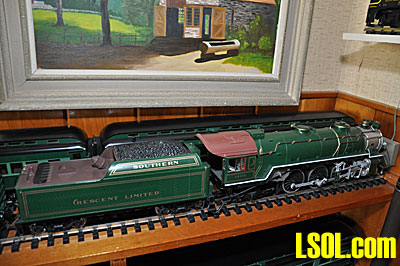 ] ]
From there he added rolling stock and the collection has grown for him to almost 40 locomotives and between 175 and 200 pieces of rolling stock. He explained that he had about all the he could exhibit in his family room so he stored the rest in the garage attic. (More on that later). He explained that he had many things he had purchased still in the box. Like many of us, he is an impulse buyer and at the ECLSTS he purchased an LGB Genesis locomotive simply because it was such a good bargain. As we looked at Paul's models he began to explain about his kitbashing techniques. He felt that Aristo Craft did a good job of designing their Mallet. He said that they started with the Norfolk & Western (USRA) design, but the Mallet was pretty much a basic Mallet since all of them were pretty much the same design. So if you do a little work on them like centering the smoke box, getting rid of all of the feedwater heater plumbing that the N & W used, moving the brake pumps to the left side and a few more little things, you could get it back to a generic Mallet, and go from there. He explained that he fabricates many of the detail parts, but he also buys a few little things. Of course, he also swaps things around from one locomotive to another to make them look like the prototypes of different roads. He says that he has "huge junk piles" of parts that he works from. 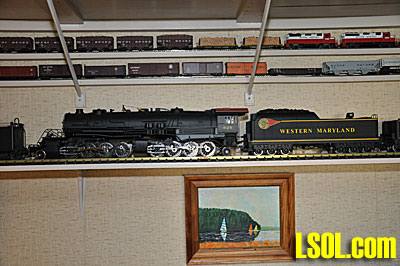 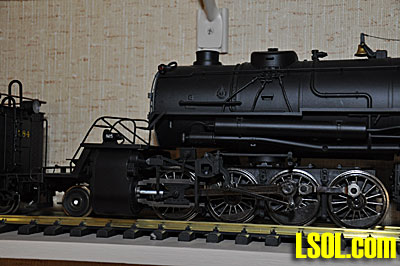
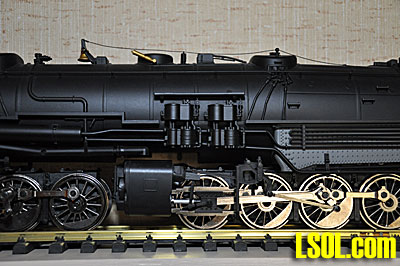 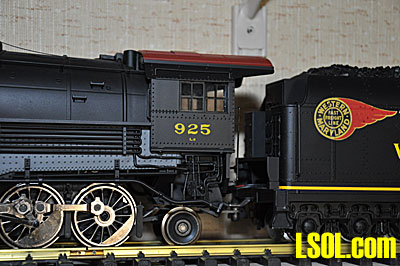 I commented that he must have a pretty good workshop and Paul said "Yes and no." He has a band saw, drill press, lathe, bead blasting box, and several other things. But he says that he does a lot of the work in his family room and small work area behind the family room. That is where he keeps his computers and the radios that are part of another hobby of Paul's, Ham Radio. You can see that guns and hunting are another of Paul's many hobbies. 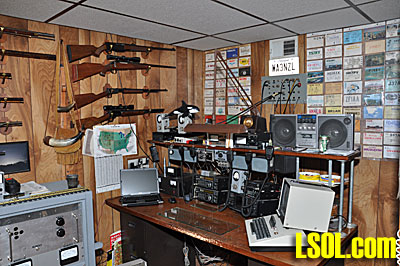
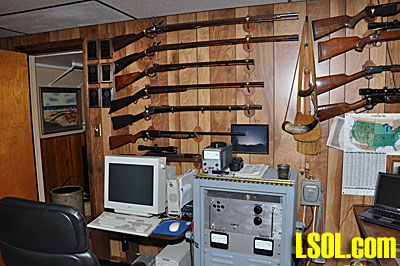 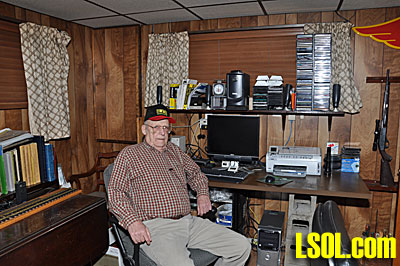 Paul was in the military, worked for the government, worked doing specialized machine work on racing cars for an import auto dealer and then joined with another guy and opened and managed a automobile dealership in the early 60's. At the dealership, he ran the service and parts departments until he and his partner were made an offer for the dealership that they couldn't refuse, so they sold it in 1984. He worked for the new owner until 1990 when he retired. As we talked about his many hobbies, he said that he had done almost all of the hobbies to include things like boats, airplanes, scuba diving until one day it occurred to him that many of the hobbies are governed by outside events and conditions that you have no control over, so he decided that he would focus on the hobbies that allowed him to do them when he wanted to do them. So he decided to spend his time on Ham Radio and trains. These could be done when he wanted to do them. The Western Maryland 0-6-0 that Paul was running at the show was built to prototype specs in the 10 days before the show. It was one of the locos that caught my eye at the show and is very nicely done. It was built from a pair of 0-4-0 Aristo Craft locos that he "chopped up". The drive unit is a three-wheel diesel block. He lengthened the boiler by using the front 2/3rds of one loco and the back 2/3rds from the other. 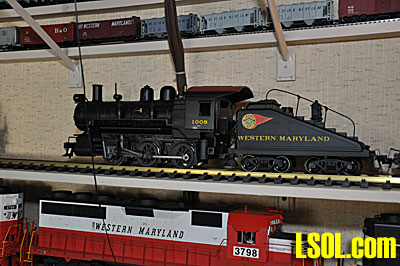 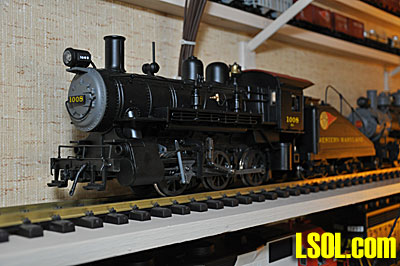 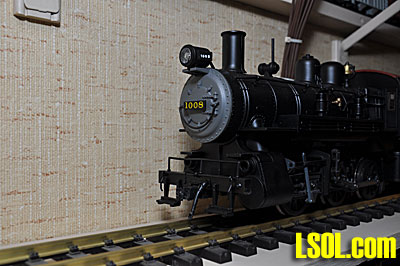 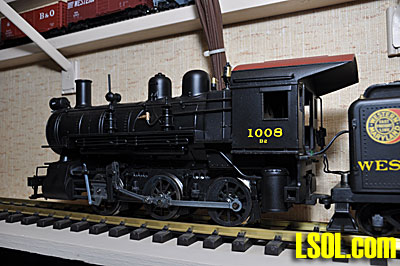
The next loco on display was also at the show. It is a Western Maryland 2-8-0 that started out as a Bachmann Big Hauler and was originally built15 years ago. He sectioned it vertically and horizontally changing the scale to 1/29. When he changed the scale he needed to change most of the small parts so that it would have the correct scale bell, whistle and other parts. He lowered and narrowed the cab and narrowed the tender. When he finished it he wasn't able to run it much because he made the drive unit from two Big Hauler drives that were notoriously weak drives that wouldn't last. Some years later he decided to buy one of the Barry's Big Train drives. After putting that into the loco he also added a Phoenix Sound System and it became a really good runner. He says it looks almost identical to the real thing, Western Maryland 348 in the early 1950's before she was scrapped. Although he has drawings for most of the Western Maryland locos, he does most of his work from looking at photos of the real thing. 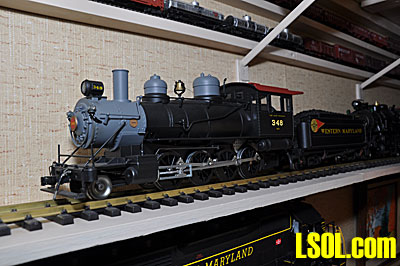
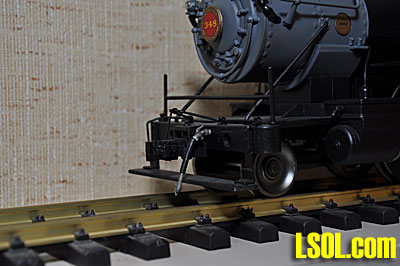 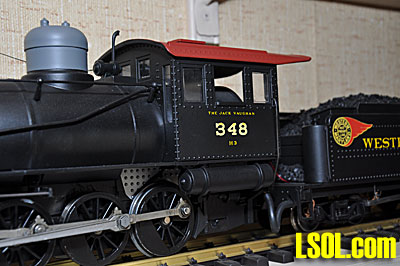 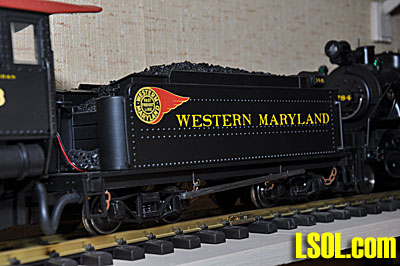 
His Pennsylvania Railroad 2-8-0 won "Best of Show" in the model contest at the ECLSTS this past October. He had a pair of Lionel Atlantics up in the attic of his garage shop that had been given to him, but were nothing but junk locos. He built two of the 2-8-0's and gave one to a friend of his in Ohio. He had a couple of Aristo Mallet drive units, left over from another bash, to replace the Lionel ones and did a lot of modifying and the result was a couple of contest winning locos. 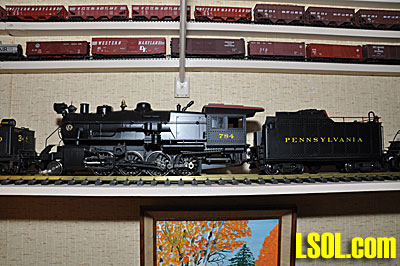 The next loco started as an Aristo Craft Mallet that has been extensively modified to look like the L-2 Western Maryland Mallet #925. The canteen pulled behind the Mallet is not really correct for a Western Maryland. Although WM ran some canteens, they didn't bother making a special one; they merely stuck another tender behind the first. His is modeled after the Norfolk and Western ones. He enjoyed making this one and it looks kind of neat behind the Mallet. 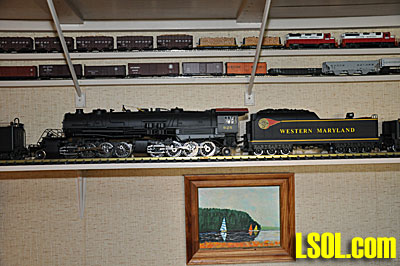
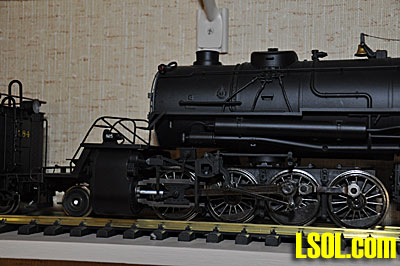 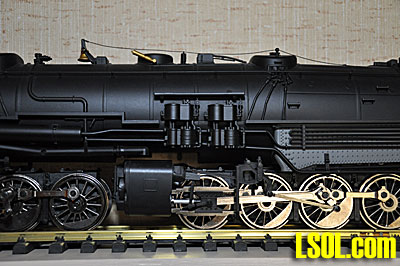 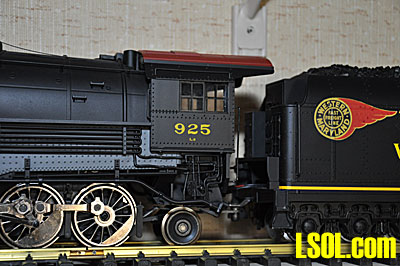 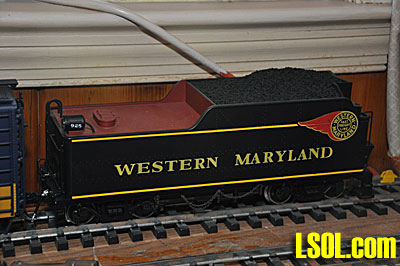 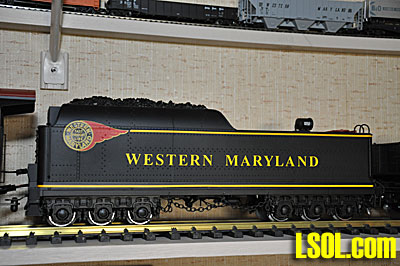
The Aristo Mallet comes with the standard USRA tender but Paul stretched and modified a couple of Pacific tenders into a 6-axle tender. As the tender is modeled it would be found behind a Heavy Consolidation. So when Paul is able to find another Mallet at a reasonable price, he plans to make a Heavy Consolidation and he will run this tender with it. He will place the original tender back with the Mallet. For his lettering Paul had a large number of decals made several years ago and uses them for many of his models, but he uses dry transfers and vinyl lettering and striping as well. 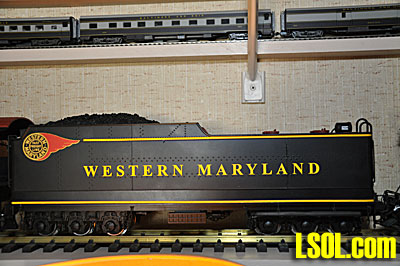 A really impressive locomotive is Paul's Western Maryland freight Northern with an even larger tender. The 6-axle tender was made from two USRA tenders using 2/3rds of the front and 2/3rds of the back of the Aristo tenders. Because of the size of the prototype tender, Paul inserted a piece of styrene to make the tender taller. The drivers on the Northern come from a USA Trains Big Boy. He got a couple of sets of drivers from USA. The locomotive is made from an Aristo Mallet with a lot of modifications. The smokebox was centered and the brake cylinders were moved up to the pilot. They were made from a couple of magic marker tubes. He uses appliances from different locos and places them correctly for the model he is making. 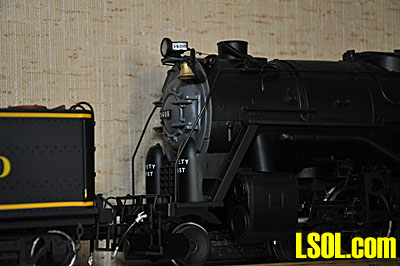 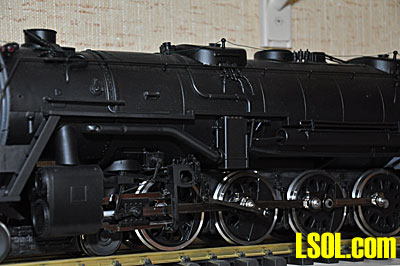
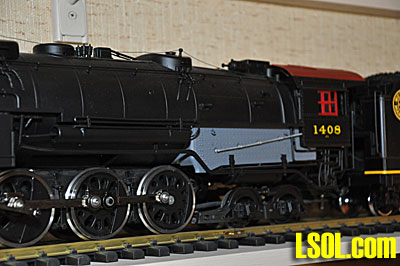 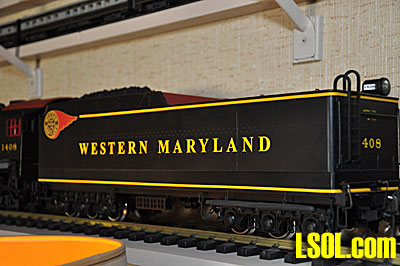 Paul is a very unassuming man and talked with me in a very matter-of-fact way about the truly remarkable modeling he does. Because he has accomplished so much in Large Scale, my interview lasted a couple of hours and in order to get all of it in a article for LSOL.com, I had to break it into two parts. Stay tuned for more about Paul and his modeling coming to you next week.
| Western Maryland Fan |
| It is great to see another Western Maryland Railway fan and a great lineup of WM steamers and cars in G-gauge. |
| Rick Henderson - 02/10/2010 - 05:11 |
| Paul Rose models |
| Wow! What a spectacular set of WM prototype models - and just a few miles up the road from my home in Gaithersburg MD. Who knew! Great work, Mr. Rose! |
| David VanBronkhorst - 02/10/2010 - 06:57 |
| The Rose Roster |
| Great article on an expert modeler. It's good to read about folks in our hobby that are not just satisfied to "shake the box." A well written article that brings insight into Paul's work. Looking forward to part II. |
| JD Miller - 02/10/2010 - 08:39 |
| Paul Rose Master Modeler |
| Outstanding work and a well written article. Sure helps our hobby with folks like Paul and Noel putting it all together for us. |
| Jim O'Connor - 02/10/2010 - 13:27 |
| 0-6-0 WM Slope back |
| Good to see an 0-6-0 with a slope back tander. When I was a kid (thousands of years ago),the Pennsy had 0-6-0's with slope backs in their Alliance,Oh yards,but see mostly rectangular tenders modeled on the current 0-6-0's and don't believe I ever recall seeing an 0-4-0 there in the yards at all. W&lE also had 0-6-0's but with the rectangular tenders. Great workmanship indeed. |
| Bill Parthe - 02/10/2010 - 14:04 |
| Paul Rose |
| Love to see what other modelers are doing close up. Great article Noel. Paul is definately an inspiration. What great work on those custom locomotives. |
| Jerry Madsen - 02/10/2010 - 21:28 |
| Paul Rose |
| Paul's workmanship and dedication is very impressive, as is his attention to detail. If I only had an ounce of his talent I'd be happy. Paul reminds me a lot of my own father. Although as my dad got older he didn't go with the larger scales, he went the other way and ended up with N gauge. His logic was that he could get more trains ans layout in the smaller places he had to work with. He was also and avid Ham radio operator and I remember helping him build his first one way back in the mid 1950's. Thanks for the wonderful article. |
| Gerry Keffer - 02/12/2010 - 17:50 |
| Western Maryland Railroad |
| For those WM fans, there is an article in the March 2010"Trains" magazine about the WM. I closed down operation on July 13, 1976 and I know that it was a very sad day for WM fans. Thank goodness the the Western Maryland Scenic railroad still runs and brings back memories of a great little Class 1 railroad. Noel |
| Noel Widdifield - 02/14/2010 - 08:58 |
Top of Page
|
|

|
IMPORTANT LINKS

Get Your Official Diploma

Watch New Videos


New Products Online
|
|
|

|



